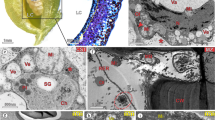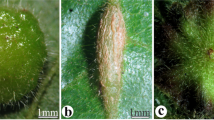Abstract
Insect-induced galls usually develop nutritional cells, which they induce and consume directly, and any metabolic modification of those cells may reflect changes of the insect’s own metabolism. The system Palaeomystella oligophaga (Lepidoptera)—Macairea radula (Melastomataceae) presents a series of natural enemies, including parasitoids and cecidophages that can function as a natural experiment, respectively removing the specific galling feeding stimulus and providing a nonspecific one. Considering that the process of induction and maintenance of gall tissues strictly depends on the constant specific stimulus of galling, question I:What kind of metabolic changes these different groups of natural enemies can promote in chemical and structural composition of these galls? II: How the specialized tissues are metabolically dependent on the constant specific stimulus of galling in latter stages of gall development? Galls without natural enemies, with parasitoids or cecidophages in larvae or pupae stages were analyzed through histochemistry and cytological profiles and all compared to galls in natural senescence state. The analysis revealed the accumulation of proteins and lipids in typical nutritive tissue and starch in the storage tissue, as well a high integrity of cellular organelles and membrane systems on galls with gallings in the larval stage. Both parasitoids and cecidophages stop galling feeding activities, which resulted in the paralysis of the stimulus that maintain the metabolism of gall tissues, leading to generalized collapse. We demonstrate that the development and metabolic maintenance of a typical nutritive tissue in these galls are completely dependent on constant larval stimulus.





Similar content being viewed by others
Change history
02 January 2019
The original version of this article unfortunately contains an error. The correct caption of Figures 2 and 3 are shown in this paper.
References
Baker JR (1958) Note on the use of bromophenol blue for the histochemical recognition of protein. Q J Microsc Sci 99:459–460
Barnewall EC, De Clerck-Floate RA (2012) A preliminary histological investigation of gall induction in an unconventional galling system. Arthropod-Plant Int 6:449–459. https://doi.org/10.1007/s11829-012-9193-4
Barraco G, Sylvestre I, Collin M, Escoute J, Lartaud M, Verdeil JL, Engelmann F (2014) Histocytological analysis of yam (Dioscorea alata) shoot tips cryopreserved by encapsulation-dehydration. Protoplasma 251:177–189. https://doi.org/10.1007/s00709013-0536-5
Barrantes G, Sandoval L, Hanson P (2017) Cocoon web induced by Eruga telljohanni (Ichneumonidae: Pimplinae) in Leucauge sp. (Tetragnathidae). Arachnology 17:245–247. https://doi.org/10.13156/arac.2017.17.5.245
Bartlett L, Connor EF (2014) Exogenous phytohormones and the induction of plant galls by insects. Arthropod-Plant Int 8:339–348. https://doi.org/10.1007/s11829-0149309-0
Becker VO, Adamski D (2008) Three new cicidogenous Paleomystela Fletcher (Lepidoptera, Coleophoridae, Momphinae) associated with Melastomataceae in Brazil. Rev Bras Entomol 52: 647-657. https://doi.org/10.1590/S0085-56262008000400017
Bedetti CS, Ferreira BG, Castro NM, Isaias RMS (2013) The influence of parasitoidism on the anatomical and histochemical profiles of the host leaves in a galling Lepidoptera–Bauhinia ungulata system. Braz J Biosci 11:242–249. https://doi.org/10.1093/aobpla/plv086
Bronner R (1992) The role of nutritive cells in the nutrition of cynipids and cecidomyiids. In: Shorthouse JD, Rohfritsch O (eds) Biology of insect induced-galls. Oxford University Press, Oxford, pp 118–140
Brundett MC, Kendrick B, Peterson CA (1991) Efficient lipid staining in plant material with Sudan red 7B or fluorol yellow 088 in polyethylene glycol–glycerol. Biotech Histochem 66:111–116. https://doi.org/10.3109/10520299109110562
Buchanan BB, Gruissem W, Jones RL (2000) Biochemistry and Mol Biol of plants. Wiley, Rockville
Carneiro RGS, Isaias RMS, Moreira ASFP, Oliveira DC (2017) Reacquisition of new meristematic sites determines the development of a new organ, the Cecidomyiidae gall on Copaifera langsdorffii Desf. (Fabaceae). Front Plant Sci 8:1622. https://doi.org/10.3389/fpls.2017.01622
Ferreira BG, Avritzer SC, Isaias RMS (2017) Totipotent nutritive cells and indeterminate growth in galls of Ditylenchus gallaeformans (Nematoda) on reproductive apices of Miconia. Flora 227:36–45. https://doi.org/10.1016/j.flora.2016.12.008
Ferreira BG, Carneiro RGS, Isaias RMS (2015) Multivesicular bodies differentiate exclusively in nutritive fast-dividing cells in Marcetia taxifolia galls. Protoplasma 252:1275–1283. https://doi.org/10.1007/s00709-015-0759-8
Ferreira BG, Falcioni R, Guedes LM, Avritzer SC, Antunes WC, Souza LA, Isaias RM (2016) Preventing false negatives for histochemical detection of phenolics and lignins in PEG-embedded plant tissues. J Histochem Cytochem 65:105–116. https://doi.org/10.1369/0022155416677035
Ferreira BG, Isaias RMS (2013) Developmental stem anatomy and tissue redifferentiation induced by a galling Lepidoptera on Marcetia taxifolia (Melastomataceae). Botany 91:752–760. https://doi.org/10.1139/cjb-2013-0125
Ferreira BG, Teixeira CT, Isaias RMS (2014) Efficiency of the polyethylene-glycol (PEG) embedding medium for plant Histochemistry. J Histochem Cytochem 62:577–583. https://doi.org/10.1369/0022155414538265
Gan S (2007) Senescence processes in plants. Blackwell, Oxford
Giron D, Huguet E, Stone GN, Body M (2016) Insect-induced effects on plants and possible effectors used by galling and leaf-mining insects to manipulate their hostplant. J Insect Physiol 84:70–89. https://doi.org/10.1016/j.jinsphys.2015.12.009
Hanson P, Nishida K (2014) Insect galls of Costa Rica and their parasitoids. In: Fernandes GW, Santos JC (eds) Neotropical insect galls. Springer, Dordrecht, pp 497–517
Hartley SE (1998) The chemical composition of plant galls: are levels of nutrients and secondary compounds controlled by the gall former? Oecologia 113:492–501
Isaias RMS, Carneiro RGS, Santos JC, Oliveira DC (2014) Gall morphotypes in the Neotropics and the need to standardize them. In: Fernandes GW, Santos JC (eds) Neotropical insect galls. Springer, Dordrecht. https://doi.org/10.1007/978-94-017-8783-3_4
Johansen DA (1940) Plant microtechnique. McGraw- Hill, New York
Karnovsky M (1965) A formaldehyde-glutaraldehyde fixative of high osmolality for use in electron microscopy. J Cell Biol 27:137–138
Katimils Y, Azmaz M (2015) Investigation on the inquilines (Hymenoptera: Cynipidae, Synergini) of oak galls from inner western Anatolia, Turkey. Turk J Zool 39:168–173
Kołodziejek I, Kozioł J, Wałęza M, Mostowska A (2003) Ultrastructure of mesophyll cells and pigment content in senescing leaves of maize and barley. J Plant Growth Regul 22:217–227. https://doi.org/10.1007/s00344-002-0024-1
Korenko S, Hamouzová K, Kysilková K, Kolářová M, Kloss TG, Takasuka K, Pekár S (2018) Divergence in host utilisation by two spider ectoparasitoids within the genus Eriostethus (Ichneumonidae, Pimplinae). Zool Anz 272:1–5. https://doi.org/10.1016/j.jcz.2017.11.006
Kraus JE, Arduin M (1997) Manual básico de métodos em morfologia vegetal. Edur, Seropédica
Lingua G, Sgorbati S, Citterio A, Fusconi A, Trotta A, Gnavi E, Berta G (1999) Arbuscular mycorrhizal colonization delays nucleus senescence in leek root cortical cells. New Phytol 141:161–169. https://doi.org/10.1046/j.1469-8137.1999.00328.x
Mani MS (1964) The ecology of plant galls. Dr. Junk, The Hague
Mete Ö, Mergen YO (2017) The community components associated with two common rose gall wasps (Hymenoptera: Cynipidae: Diplolepidini) in Turkey. Turk J Zool 41:696–701. https://doi.org/10.3906/zoo-1602-20
Meyer J, Maresquelle HJ (1983) Anatomie des galles. Gerbrüder Borntrager, Berlin
O'brien TP, Feder N, McCully ME (1964) Polychromatic staining of plant cell walls by toluidine blue O. Protoplasma 59:368–373. https://doi.org/10.1007/BF01248568
Oliveira DC, Carneiro RGS, Magalhães TA, Isaias RMS (2011) Cytological and histochemical gradients on two Copaifera langsdorffii Desf. (Fabaceae) - Cecidomyiidae gall systems. Protoplasma 248:829–837. https://doi.org/10.1007/s00709-010-0258-x
Oliveira DC, Isaias RMS (2010) Cytological and histochemical gradients induced by a sucking insect in galls of Aspidosperma australe Arg. Muell (Apocynaceae). Plant Sci 178:350–358. https://doi.org/10.1016/j.plantsci.2010.02.002
Oliveira DC, Isaias RMS, Fernandes GW, Ferreira BG, Carneiro RGS, Fuzaro L (2016) Manipulation of host plant cells and tissues by gall-inducing insects and adaptive strategies used by different feeding guilds. J Insect Physiol 84:103–113. https://doi.org/10.1016/j.jinsphys.2015.11.012
Oliveira DC, Moreira ASFP, Isaias RMS (2014) Functional gradients in insect gall tissues: studies on Neotropical host plants. In: Fernandes GW, Santos JC (eds) Neotropical insect galls. Springer, Netherlands, Dordrecht. https://doi.org/10.1093/aobpla/plv086
Oliveira DC, Moreira ASFP, Isaias RMS, Martini VC, Rezende UC (2017) Sink status and photosynthetic rate of the leaflet galls induced by Bystracoccus mataybae (Eriococcidae) on Matayba guianensis (Sapindaceae). Front Plant Sci 8:01249. https://doi.org/10.3389/fpls.2017.01249
Raman A (2007) Insect-induced plant galls of India: unresolved questions. Curr Sci 92:748–757
Rohfritsch O (1992) Patterns in gall development. In: Shorthouse JD, Rohfritsch O (eds) Biology of insect-induced galls, vol 87. Oxford University Press, Oxford, p 101
Sanver D, Hawkins BA (2000) Galls as habitats: the inquiline communities of insect galls. Basic Appl Ecol 1:3–11. https://doi.org/10.1078/1439-1791-00001
Schönrogge K, Harper LJ, Lichtenstein CP (2000) The protein content of tissues in cynipid galls (Hymenoptera: Cynipidae): similarities between cynipid galls and seeds. Plant Cell Environ 23:215–222. https://doi.org/10.1046/j.1365-3040.2000.00543.x
Shorthouse JD, Wool D, Raman A (2005) Gall-inducing insects – nature’s most sophisticated herbivores. Basic Appl Ecol 6:407–411. https://doi.org/10.1016/j.baae.2005.07.001
Steinbauer MJ, Burns AE, Hall A, Riegler M, Taylor GS (2014) Nutritional enhancement of leaves by a psyllid through senescence-like processes: insect manipulation or plant defence? Oecologia 176:1061–1074. https://doi.org/10.1007/s00442-014-3087-3
Stone GN, Schönrogge K (2003) The adaptive significance of insect gall morphology. Trends Ecol Evol 18:512–522. https://doi.org/10.1016/S0169-5347(03)00247-7
Sugiura S, Yamazaki K (2009) Gall-attacking behavior in phytophagous insects, with emphasis on Coleoptera and Lepidoptera. Terr Arthropod Rev 2:41–61. https://doi.org/10.1163/187498309x435658
Sugiura S, Yamazaki K, Osono T (2006) Consequences of gall tissues as a food resource for a tortricid moth attacking cecidomyiid galls. Can Entomol 138:390–398. https://doi.org/10.4039/n05-001
Thomas H, Stoddart JL (1980) Leaf senescence. Ann Rev Plant Physiol 31: 83-111.
Van Hezewijk BH, Roland J (2003) Gall size determines the structure of the Rabdophaga strobiloides host–parasitoid community. Ecol Entomol 28:593603–593603. https://doi.org/10.1046/j.1365-2311.2003.00553.x
Vecchi C, Menezes NL, Oliveira DC, Ferreira BG, Isaias RMS (2013) The redifferentiation of nutritive cells in galls induced by Lepidoptera on Tibouchina pulchra (Cham.) Cogn. Reveals predefined patterns of plant development. Protoplasma 250:1363–1368. https://doi.org/10.1007/s00709-013-0519-6
White TC (2012) The inadequate environment: nitrogen and the abundance of animals. Springer Science & Business Media. https://doi.org/10.1007/978-3-642-78299-2
Shorthouse JD, Rohfritsch O (1992) Biology of insect-induced galls. New York, Oxford
Zamora R, Gómez JM (1993) Vertebrate herbivores as predators of insect herbivores: an asymmetrical interaction mediated by size differences. Oikos 66:223–228. https://doi.org/10.2307/3544808
Zhang H, Guiguet A, Dubreuil G, Kisiala A, Andreas P, Emery RJ, Huguet E, Body M, Giron D (2017) Dynamics and origin of cytokinins involved in plant manipulation by a leaf-mining insect. Insect Sci 24:1065–1078. https://doi.org/10.1111/1744-7917.12500
Acknowledgments
The authors are grateful for Fundação de Amparo à Pesquisa do Estado de Minas Gerais (FAPEMIG), Instituto Nacional de Ciência e Tecnologia dos Hymenoptera Parasitóides (INCT/HYMPAR), Programa Ecológico de Longa Duração (PELD), and Conselho Nacional de Desenvolvimento Científico e Tecnológico (CNPq)—DCO fellowship (PQ 307011/2015). They thank the Laboratório Multiusuário de Microscopia de Alta Resolução (LaBMic) for ultrastructural analysis, and the assistance in the histochemical processes provided by Ana Flávia de Melo Silva and Phabliny M. S. Bomfim.
Funding
The Coordenação de Aperfeiçoamento de Pessoal de Nível Superior—Brasil (CAPES)—finance code 001, financed this study in part.
Author information
Authors and Affiliations
Corresponding author
Ethics declarations
Conflict of interest
The authors declare that they have no conflicts of interest.
Additional information
Handling Editor: Hanns H. Kassemeyer
Rights and permissions
About this article
Cite this article
Rezende, U.C., Cardoso, J.C.F., Kuster, V.C. et al. How the activity of natural enemies changes the structure and metabolism of the nutritive tissue in galls? Evidence from the Palaeomystella oligophaga (Lepidoptera) -Macairea radula (Metastomataceae) system. Protoplasma 256, 669–677 (2019). https://doi.org/10.1007/s00709-018-1321-2
Received:
Accepted:
Published:
Issue Date:
DOI: https://doi.org/10.1007/s00709-018-1321-2




